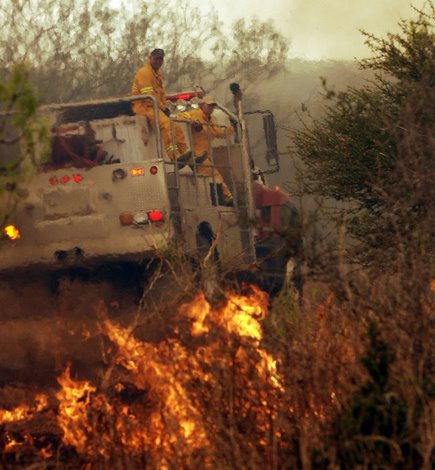
A wildfire burned 95 percent of Texas Parks and Wildlife Department’s 15,200-acre Chaparral Wildlife Management Area in LaSalle and Dimmit Counties south of San Antonio. The fire started late Friday, March 14, and by Monday morning, March 17, was almost entirely burned out on the WMA, where it caused no injuries and spared most of the facilities but did destroy a research building.
When the fire started, eight parties of public hunters were on Chaparral WMA, but the two staff members on duty were able to evacuate all of them safely. “The powers that be must have been watching over us,” said David Synatzske, Chaparral WMA manager.
“The most important thing is that all hunters were safely evacuated by staff, and there was no loss of life or injury to any of the hunters, staff, or the hundreds of folks who fought this fire.”
Synatzske said two of the hunters were found Friday after dark in a pasture without a vehicle, spotted by a WMA staffer who had gone up in a military helicopter to help find them. The Texas Forest Service said by early Monday the fire was 100 percent contained, and had burned a total of 67,500 acres in South Texas. The service said they believe the fire started on a ranch in Dimmitt County, although the exact cause is still under investigation.
Aerial views showed the main line of fire swept right over the WMA headquarters complex and residence. Synatzske, however, said almost all structures and vehicles were spared because of good fire lanes maintained by staff, and by a paved parking area and 35 miles of paved roads provided by TXDOT through an agreement with TPWD.
The WMA also benefited from a huge outpouring of support to fight the fire from more a dozen local fire departments, most of them staffed by volunteers, and from state and federal agencies and organizations like the Red Cross. The site had some tires burned off a tractor and lost some trailer beds, but the biggest loss was the research building, including records of past projects. Perhaps ironically, Synatzske says the fire now poses a huge research opportunity.
“This is a historical event, probably one of the largest burns that ever occurred in South Texas. We’ll be able to learn a lot about successional change and restoration of the landscape. That’s what we’re here for; we’re a research-oriented site, and this will be a focus of research for years to come.”




thank god there wasn’t more damage to wildlife and facilities. i’ve had the oportunity to hunt at chaparral a few times and can’t imagine a fire so big in south texas. maybe something good will come out of this.
Richard Bell
Wildfires are often a natural phenomenon of nature and catastrophic fires are a good argument for prescribed (controlled) burning. This can be more important “before” events, such as droughts, happen.
Bill, I agree with what you wrote but there are also certain years in which wildfires have the upper hand. Here in Texas, it rained like crazy the first six months of the year. The rain stopped in July and now most of the state is covered in tall, brown grass. Even areas that were burned last year are set to burn again. Wildfires are natural, so folks better plan their prescribed fires soon!